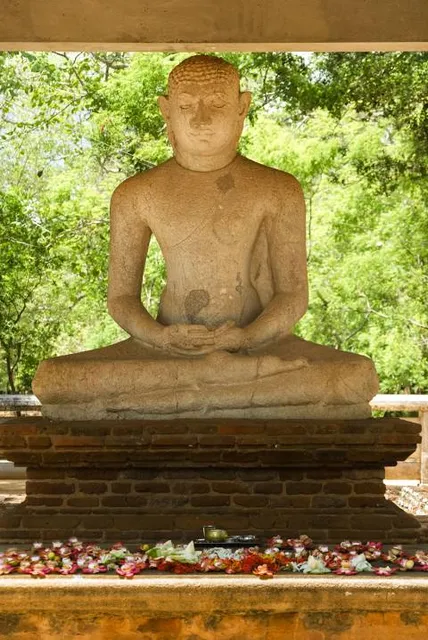Samadhi Buddha Statue
Samadhi Buddha Statue things to do, attractions, restaurants, events info and trip planning
Description
cultural
accessibility
The Samadhi Buddha is a famous statue situated at Mahamevnāwa Park in Anuradhapura, Sri Lanka. The Buddha is depicted in the position of the Dhyana Mudra, the posture of meditation associated with his first Enlightenment. This statue is 7 feet 3 inches in height and carved from dolomite marble.
attractions: Abhayagiriya, Abhayagiri Pagoda, Lankaramaya, Anuradhapura Moonstone, Anuradhapura Moonstone |සඳකඩ පහන, අභයගිරි කෞතුකාගාරය - Abhayagiri Museum, Twin ponds (කුට්ටම් පොකුණ), Elephant Pond ඇත් පොකුණ, Kuttam Pokuna Viharaya, Rathna Prasadaya | මුරගල, restaurants:
Ratings
Description
The Samadhi Buddha is a famous statue situated at Mahamevnāwa Park in Anuradhapura, Sri Lanka. The Buddha is depicted in the position of the Dhyana Mudra, the posture of meditation associated with his first Enlightenment. This statue is 7 feet 3 inches in height and carved from dolomite marble.
Posts
Samadhi Buddha Statues, Anuradhapura, Sri Lanka. Many archeologists including Prof. Paranawithana believe that Buddha statues have been created in India for the first time and influenced Sri Lankan sculpture and the earliest statues can be seen in the country only after 2nd or 3rd Century AD. Quoting literary evidence, Mahawansa and Buddhist commentaries, some other scholars Including MH Sirisoma and Charls Godakumbura former DGs of Dept. of Archeology, DT Devendra and Martin Wickramasingha believe, that Sri Lankan Buddha statues have been created in Sri Lanka before India or simultaneously. To support this opinion they say that the arrival of Sri Maha Bodhi, various arts and craft were introduced to Sri Lanka. Mahawansa mentions that during the King Dewanam Piyatissa period a granite statue (Urusilapatima) was placed at the Thuprama premises. At the beginning, people may have created Buddha statues with perishable material such as clay or wood. Several literature sources mention about Buddha statues from the 2nd C. BC. However this opinion has not been established yet. The earliest Buddha statues are found in Mahailuppalama made out of marble or lime stones and in Ruwanweliseya, which belong to the 2nd Century AD. Both are upright statues. Archeologists believe that Sinhalese artists have created this statue having the instructions of Andra artists and the material. There are records that in the later period, the eyes of Buddha statues were adorned with gems and gold gilded. "Smadhi Buddha Statue" from India? Sitting posture or the psychological implications of the Smadhi or Anuradhapura Buddha image, contradict all such speculations. “In Ceylon the making of the Buddha Image developed not as a commercial art but as a religious art under the guidance of monks and sculptors who derived inspiration from their devotional worship. Among the old Buddha images of Ceylon there is none that represents Saranath or ornamental Matura type. Ceylon monks seem to have conservatively and fiercely stuck to their austere conception of the iconography of the Buddhas Image ”. "The Samadhi or Anuradhapura Buddha Statue easily surpasses the Buddhagaya image in representing in visual form the implications of the Buddhahood”, Martin Wickrakasingha - 1968. Early Anuradhapura period (2nd C AD to 5th C AD), Sri Lankan sculptor has shown his ability to create Buddha statues, which depicted the Budhha’s sublime qualities such as serenity, compassion, loving kindness, and deep meditation in a very simple manner. The facial expression is very effective. According to the Archaeologist, "Samadhi Buddha Statue" depicts following Main features. - Robe covers single shoulder - No pleats of the robe and it is shown by just a line in the early period - Full round hair with wide forehead - Facial expression of compassion, kindness and deep meditation, serenity and spiritual purity. - Deep Meditation Posture This is the period that the Sri Lankan Buddha statues started to show the Sinhalesevtradition. What the Sri Lankan sculptor wanted was not to follow the texts on iconography to the letter but to show sublime qualities of the Buddha.
Dasun TharangaDasun Tharanga
00
The Samadhi Buddha Statue in Anuradhapura is one of Sri Lanka's most revered and iconic Buddhist sculptures. Located in the Mahamevnāwa Park of the ancient city of Anuradhapura, this statue dates back to the 4th or 5th century AD and is a masterpiece of ancient Sinhalese art. The statue depicts the Buddha in a state of deep meditation (Samadhi), seated in the Dhyana Mudra, with his hands resting on his lap and his legs crossed in the traditional lotus position. The serene expression on the Buddha's face reflects a profound sense of inner peace and spiritual calmness, making it a symbol of tranquility and enlightenment. Carved out of a single block of granite, the Samadhi Buddha Statue is about 7 feet tall and is renowned for its simplicity and grace. Unlike some other Buddha statues that are heavily adorned, this statue is noted for its minimalist design, focusing solely on the meditative posture and the Buddha's tranquil expression. The Samadhi Buddha is considered one of the finest examples of early Buddhist sculpture in Sri Lanka and is highly respected by both locals and visitors. It is often regarded as a powerful spiritual symbol, and many Buddhists visit the statue to meditate or offer prayers. The statue is an essential part of the larger Anuradhapura UNESCO World Heritage Site, which was the capital of ancient Sri Lanka and remains one of the most significant cultural and religious sites in the country..
Priyanga SampathPriyanga Sampath
00
මහමෙවුනා උයනේ නොපිහිටි අනුරාධපුරයේ සමාධි පිළිමයේ ඔබ නොදත් තතු ශ්රී ලංකාවේ පුරාණ ශිලාමය බුදු පිළිම අතරින් චිරප්රසිද්ධියට පත්ව ඇත්තේ අනුරාධපුර පුරාණ අභයගිරි විහාර භූමියේ කුට්ටම් පොකුණටත් අභයගිරි මහ සෑයටත් අතර පුරාණ බෝධිඝරයක් තුළ දක්නට ලැබෙන සුප්රසිද්ධ හිඳි පිළිම වහන්සේ ය. වර්තමානයේ දෙස් විදෙස් ලක්ෂ සංඛ්යාත ජනතාවක් මෙම පිළිම වහන්සේ දැක බලා බුද්ධාලම්බන ප්රීතියෙන් වැඳ පුදා ගැනීමටත් දැකගැනීමටත් පැමිණෙති. සිංහල කලාකරුවා අතින් නිර්මාණය කළ එම පිළිමය ප්රසිද්ධියට පත් ව ඇත්තේ එහි ඇති අති සුන්දර කලාත්මක බව නිසා ම පමණක් නොවේ. ගොරහැඩි මහ ගලක් සුමුදු ව ඔපමට්ටම් කොට එයට අනන්ත වූ අපරිමිත වූ බුදුගුණ හා ශාන්ත වූ භාවනානුයෝගි බව ද ඇතුළත් කරමින් සැදැහැවතුන් තුළ පහන් සිත් ඇති වන පරිදි මහත් සංයමයකින් යුක්ත ව එම ප්රතිමාව නෙළා ඇති හෙයිනි. මෑතකාලින පෙරදිග ලෝකයේ විශිෂ්ට චරිතයක් වන අභාවප්රාප්ත භාරතීය අග්රාමාත්යවරයාණන් වූ ශ්රී ජවහර් ලාල් නේරු තුමා අධිරාජ්යවාදී බ්රිතාන්යයන් විසින් සිපිරිගෙයි රඳවා සිටි කාලවකවානුවේ දී තමාගේ චිත්ත ඒකාග්රතාව රැකගත්තේ එම බුද්ධ ප්රතිමාවේ ඡායාරූපයක් ගෙන්වාගෙන එය තමා ඉදිරියෙන් තබා ඒ දෙස බලාගෙන භාවනා කිරීමෙන් බව එතුමා සඳහන් කර ඇත. මෙම සමාධි බුදු පිළිමයේ විශිෂ්ටත්වය නිගමනය කිරීමෙහි ලා මෙම සාධකය පමණක් වැදැගත් යැයි දැක්වීම ප්රමාණවත් ය. වීරාසන ඉරියව්වෙන් පාද පිහිටුවා දෑත් සමාධි මුද්රාවෙන් තබා වැඩසිටින ප්රතිමාව ගිරිමානන්ද සූත්රයේ දැක්වෙන පිරිදි ආනාපාන භාවනාවේ යෙදී සිටිතියි සැලකිය හැක්කේ දෑස්වල දෘෂ්ටිය නාසාග්රය ඔස්සේ දෑතෙහි අත්ල මතට යොමු කර ඇති ආකාරයත් ආනාපන භාවනාවක දී හුස්ම ඉහළ පහළ ගන්නා විට උදරය පිහිටන ආකාරයට මෙම ප්රතිමාව නෙළා තිබිමත් සලකන කල්හි ය. 1872 දී ප්රථම වතාවට මෙම බුදු පිළිමය දුටු උතුරුමැද පළාතේ එවකට බ්රිතාන්ය ඒජන්තවරයා වූ එච්.එච්.කැමරන් මහතා 1896 වර්ෂයේ සිය පාලන වාර්තාවේ මෙසේ සඳහන් කර ඇත. “මේ පළාතෙන් යෑමට පෙර මා විසින් ඉටු කළ යුතු යැයි සිතාගෙන සිටි එක් කාර්යයක් අනුරාධපුරයේ ඇත. එය මාගේ අනුප්රාප්තික නිලධාරීන්ට පැවරීමට මට සිදුව තිබේ. හුදකලා බවින් ද මහ වනයේ නිහැඬියාවෙන් ද නූතන ශිෂ්ටාචාරයේ අහිතකර බලපෑම් නැති හෙයින් ද හිඳි පිළිම වහන්සේට ලැබෙන ගම්භීරත්වයට හානි නොවන පරිදි බුදු පිළිමය ඉදිරිපසින් ම දිවෙන වට රවුම් පාර යාර සියයක් පමණ එහායින් හරවා යැවීමයි. 1872 වසරේ දී මා මේ බුදු පිළිමය දුටුවේ එවැනි වාතාවරණයක ය. පසුව 1895 මුල් භාගයේ දි මේ බුදු පිළිමය දුටු විට එහි සිරි පතුළ අසලට ම බොරලු දමන ලද පාරක් වැටී තිබෙනු දැකීමෙන් මම බලවත් සේ කම්පා වීමි. උන් වහන්සේගේ ශාන්ත සමාධි සුවයට ද හුදකලාභාවයට ද රෝදවල ශබ්දයෙන් හා සංචාරකයන්ගේ අදාන්ත සිනාවෙන් ද බාධා පැමිණවීම ඇත්තෙන් ම නිගරුවකි.” මේ බෞද්ධයෙකු ද නොවන විදේශිකයෙකුගේ ප්රකාශයකි. එම මාර්ගය මේ ලිපියේ කතුවරයාගේ මැදිහත් වීමෙන් වසර කීපයකට පෙර වෙනස් කර බුදු පිළිමයට බොහෝ දුරින් යෑමට සැලැස්වීමෙන් කැමරන් මහතාගේ අපේක්ෂාව ඉටු කර ඇත. එම කාලය වන විට මෙම බුදු පිළිමයේ නාසයේ කොටසක් කැඩී තිබුණේ ස්වභාවධර්මයේ අකාරුණිකත්වය නිසා විය යුතු ය. ශ්රී ලංකාවේ පුරාවිද්යා දෙපාර්තමේන්තුව පිහිටුවීමෙන් පසු 1930 දශකයේ දී නාසයේ කැඩී තිබූ කොටස සාදන ලද්දේ පුරාවිද්යා කොමසාරිස් වී සිටි ලෝංහර්ස්ට මහතාගේ මැදිහත් වීමෙනි. අලුතින් එක් කළ කොටසින් නාසයේ දිග වැඩි වීම නිසා මුහුණට අවලස්සන පෙනුමක් එක් විය. මේ නිසා රත්මලානේ පරමධම්ම චේතිය විහාරවාසී ප්රතිමා ශිල්පියෙකු වූ මාපලගම විපුලසාර හිමියන් විසින් එහි දිග අවම කොට අද දක්නට ඇති තත්ත්වයට පත් කරන ලදී. පුරාණයේ දී මේ පිළිමයේ ශරීරය වර්ණ ගන්වා තිබූ බවට ඉතා සුළු වශයෙන් සාධක තවමත් ඉතිරි වී තිබේ. ප්රතිමාවේ මුලින් තිබූ වර්ණ කාලයාගේ ඇවෑමෙන් අවපැහැ ගැන්වී ඇත. මෙම ප්රතිමාව වර්තමානයේ ශ්රී ලංකාවේ දක්නට ලැබෙන ඉතාම කලාත්මක බුදු පිළිමය බව මහාචාර්ය සෙනරත් පරණවිතාන ඇතුළු උගතුන් විසින් පිළිගෙන ඇත. එසේ වුව ද මෙම බුදු පිළිමය පිහිටි ස්ථානය පිළිබඳ පොදු ජනවහරේ සඳහන් වන්නේ මහමෙව්නා උයනේ බව ය. එහෙත් පුරාණ ලේඛන පරිශීලනය කිරීමේ දී පෙනි යන්නේ මේ බුදු පිළිමය පිහිටා ඇත්තේ මහමෙව්නාවේ නොවන බව ය. මහමෙව්නා උද්යානය පිළිබඳ ප්රථමයෙන් ම දීපවංශය, මහාවංශය, සමන්තපාසාදිකාව ඇතුළු ග්රන්ථයන්හි ද මහා බෝධිග්රන්ථිපද විවරණයේ ද සඳහන් වන්නේ මිහිඳු මහ රහතන් වහන්සේ අනුරපුරයට වැඩම කිරීම සම්බන්ධ ව ය. එසේ අනුරපුරයට වැඩම කළ උන් වහන්සේ විසින් පසු දින ඇතුළු නුවර දකුණු දොරටුව ඉදිරිපිට වූ නන්දන උයනේ සිට හුදී ජනයාට දහම් දෙසන ලදී. අනතුරු ව එම ස්ථානය රාත්රි කාලයේ පවා ඝෝෂාකාරී පෙදෙසක් වූයෙන් රාත්රිය ගත කිරීම සඳහා පෙරළා මිහින්තලයට වැඩම කරමින් සිටිය දි එම ගමන වැළැක්වූ රජතුමා තම පියා වූ මුටසීව රජතුමා විසින් රාජකීයයන් සඳහා කරවූ මහමෙවුනා උයන ඇති බවත් එය ඝෝෂා රහිත නගරයට නොළං නුදුරු ස්ථානයක් බව පවසා එය පූජා කර තිබේ.
Isuru AbeygunawardanaIsuru Abeygunawardana
00
The Samadhi Buddha statue is a renowned ancient statue of the Buddha that can be found in Anuradhapura, Sri Lanka. It is a remarkable piece of artwork that dates back to the 4th century AD and is considered to be one of the finest examples of ancient Sri Lankan sculpture. The statue depicts the Buddha seated in the meditative posture known as Samadhi, with his hands resting in his lap and his eyes closed in deep contemplation. The statue is carved out of a single piece of granite and stands at over seven feet tall, making it an impressive sight to behold. The Samadhi Buddha statue is renowned for its serene and peaceful expression, which is said to embody the Buddha's teachings on inner peace and tranquility. Visitors to Anuradhapura can marvel at the exquisite craftsmanship of the statue and reflect on its message of inner stillness and contemplation. The Samadhi Buddha statue is a testament to Sri Lanka's rich cultural heritage and a must-see destination for anyone interested in Buddhist art and philosophy.
Hansani ErangaHansani Eranga
00
The Samadhi Statue is a sculptural masterpiece from the early period of the Anuradhapura era, made of dolomite marble and standing at 7 feet 3 inches in height It was discovered in 1886 near the Abhayagiri Monastery, fallen to the ground with damages to the nose. It was reconstructed unsuccessfully and then re-constructed again in 1914, which is still visible. The statue is believed to have been one of four placed around the Bodhi tree, and the one facing north has survived. The Samadhi Statue is carved from a single rock, with a thin body-hugging robe covering only the left shoulder and the right leg lying over the left leg in the Veerasana Posture. The hair is carved in snail-like curls, and the eyes are hollow, indicating they were impressed with crystal or precious stones. Looking at the face of the statue from three sides shows three different features, a slightly sad expression on one side, a slightly smiling face on the other, and a neutral expression from the front.
Dumindu TharangaDumindu Tharanga
00
Samadhi Statue is considered one of the best sculptures in the Anuradhapura era. It is thought to be done during the 3rd or the 4th century. It is made out of dolomite marble and stands 7 feet 3 inches (2.21 metres) in height. This statue was found in the present location in 1886 fallen to the ground with damages to the nose. It was then erected and the nose was reconstructed. In 1914, it was found damaged by treasure hunters and re constructed again. The statue’s eyes are hollow indicating they were impressed with crystal or precious stones. It is unclear whether this and the 2nd statue were brought from another vihara or they were originally kept here. It is said that when you look at the face of the statue from three sides they show 3 different features. Looking at the profile of the face from left and right they show a slight sadness and a slightly smiling face on the other. Looking from the front, the face shows neutral features.
Thusitha AbeykoonThusitha Abeykoon
00
Nearby Attractions Of Samadhi Buddha Statue
Abhayagiriya
Abhayagiri Pagoda
Lankaramaya
Anuradhapura Moonstone
Anuradhapura Moonstone |සඳකඩ පහන
අභයගිරි කෞතුකාගාරය - Abhayagiri Museum
Twin ponds (කුට්ටම් පොකුණ)
Elephant Pond ඇත් පොකුණ
Kuttam Pokuna Viharaya
Rathna Prasadaya | මුරගල

Abhayagiriya
4.8
(671)Click for details

Abhayagiri Pagoda
4.8
(524)Click for details

Lankaramaya
4.7
(301)Click for details

Anuradhapura Moonstone
4.8
(297)Click for details




